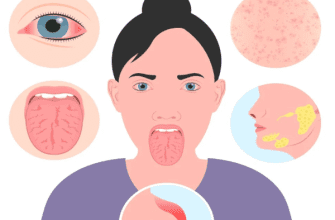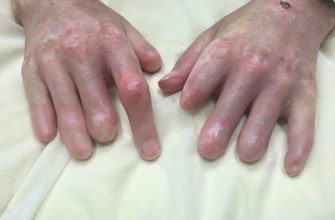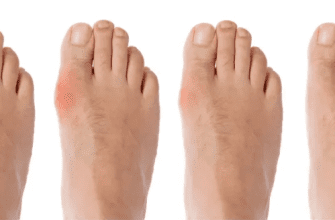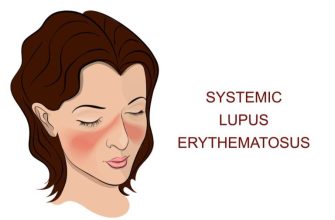What It Is
Bechterev’s disease, more commonly known internationally as Ankylosing Spondylitis (AS), is a chronic inflammatory disease that primarily affects the joints of the spine and the sacroiliac joints (where the base of your spine connects to your pelvis). Over time, the chronic inflammation can lead to the vertebrae (the bones in your spine) fusing together. This fusion makes the spine less flexible and can result in a stooped, forward-curving posture. In some cases, it can also affect other joints, eyes, and organs.
Causes
The exact cause of AS is unknown, but it is strongly linked to genetic factors.
- Genetic Predisposition: The majority of people with AS carry a specific gene called HLA-B27. However, having this gene does not mean you will definitely get the disease; it only increases your susceptibility.
- Immune System Dysfunction: AS is an autoimmune disease, meaning the body’s immune system mistakenly attacks its own healthy tissues, particularly in the entheses (the places where ligaments and tendons attach to bone).
- Environmental Triggers: It is believed that in genetically predisposed individuals, an unknown environmental trigger, such as a bacterial infection, might activate the disease.
Symptoms
Symptoms of AS can vary greatly but often develop slowly over months or years. They typically begin in early adulthood.
- Primary Symptoms:
- Chronic Pain and Stiffness: A persistent, dull pain in the lower back, buttocks, and hips. This is often worse in the morning or after periods of inactivity (e.g., sitting for a long time).
- Improvement with Movement: Pain and stiffness typically improve with exercise and get worse with rest.
- Sleep Disturbance: Pain can often wake you up in the second half of the night.
- Reduced Spinal Flexibility: Over time, you may find it difficult to bend or twist your spine.
- Other Possible Symptoms:
- Pain in other joints: Such as the hips, knees, shoulders, or ribs.
- Enthesitis: Pain where tendons or ligaments attach to bone, commonly at the heel (Achilles tendonitis) or under the foot (plantar fasciitis).
- Fatigue: A general feeling of tiredness and lack of energy.
- Uveitis (Iritis): A painful, red, and inflamed eye that is sensitive to light and can blur vision. This is a medical emergency and requires prompt treatment.
- Inflammatory Bowel Disease (IBD): Some people with AS also have Crohn’s disease or ulcerative colitis.
- Psoriasis: A skin condition causing red, scaly patches.
- In rare, advanced cases: The fused spine can make it difficult to expand the chest, leading to breathing problems.
Diagnosis
Diagnosing AS can be challenging as it is often mistaken for common back pain. The process typically involves:
- Medical History and Physical Exam: Your doctor will ask about your symptoms, their pattern (e.g., worse in the morning), and family history. They will also test the range of motion in your spine.
- Blood Tests: To check for markers of inflammation (ESR and CRP) and for the presence of the HLA-B27 gene.
- Imaging:
- X-rays: To look for changes and fusion in the sacroiliac joints and spine. These changes may not appear until years after the disease starts.
- MRI (Magnetic Resonance Imaging): Can detect early inflammation and changes in the sacroiliac joints and spine before they are visible on an X-ray, allowing for earlier diagnosis.
Treatment
There is no cure for AS, but treatment can effectively manage symptoms, reduce pain and stiffness, prevent complications, and maintain posture and mobility.
- Physiotherapy and Exercise: This is the cornerstone of treatment. A physiotherapist can design a program including daily stretching and strengthening exercises to maintain posture and flexibility. Swimming is highly recommended.
- Medications:
- NSAIDs: Nonsteroidal anti-inflammatory drugs (e.g., Naproxen, Ibuprofen) are usually the first line of treatment to reduce pain and inflammation.
- DMARDs: Disease-modifying antirheumatic drugs (e.g., Sulfasalazine) can help with pain in peripheral joints but are less effective for spinal symptoms.
- Biologics: TNF-inhibitors (e.g., Adalimumab, Etanercept) and IL-17 inhibitors (e.g., Secukinumab) are very effective at reducing inflammation and halting disease progression. They are typically used if NSAIDs are not effective.
- Surgery: In severe cases, joint replacement (like hip replacement) or surgery to correct severe spinal deformity may be necessary.
Prevention
Since the cause is largely genetic, AS cannot be prevented. However, early diagnosis and consistent treatment are the best ways to prevent the most severe complications, such as spinal fusion and deformity.
Prognosis
The prognosis for AS varies. For most people, it is a chronic condition with periods of flare-ups and remission. With modern treatments, the majority of individuals with AS can lead full, active lives. The disease does not typically shorten life expectancy, but it can impact its quality if not managed properly. Severe complications are now much less common thanks to advanced therapies.
How to Understand That You Need to See a Doctor
You should consider seeing a doctor (starting with your primary care physician, who may refer you to a rheumatologist, a specialist in arthritis and autoimmune diseases) if you experience a cluster of the following symptoms, especially if you are under 45:
- Persistent lower back pain and stiffness that has lasted for more than three months.
- Pain and stiffness that are clearly worse in the morning or after rest.
- Pain that improves with physical activity or exercise and gets worse when you are still.
- Back pain that started in your late teens, 20s, or 30s.
- Pain that wakes you up in the second half of the night.
- Pain in the buttocks that sometimes alternates from side to side.
- You have a family history of AS or other autoimmune arthritis.
Do not dismiss persistent back pain as a simple mechanical issue. The inflammatory nature of AS has distinct clues, and recognizing them is the first step toward getting an accurate diagnosis and effective treatment.






